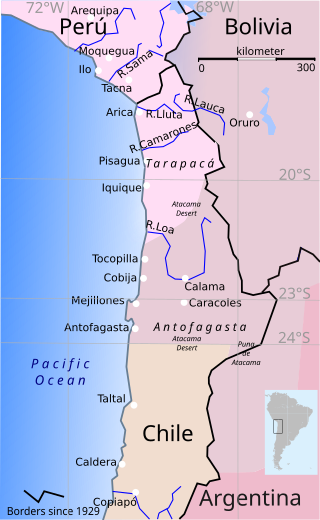
The War of the Pacific, also known by multiple other names, was a war between Chile and a Bolivian–Peruvian alliance from 1879 to 1884. Fought over Chilean claims on coastal Bolivian territory in the Atacama Desert, the war ended with victory for Chile, which gained a significant amount of resource-rich territory from Peru and Bolivia.

Tacna is the southernmost department and region in Peru. The Chilean Army occupied the present-day Tacna Department during the War of the Pacific from 1885 until 1929 when it was reincorporated into Peru.

Francisco Bolognesi Cervantes was a Peruvian military colonel. He is considered a national hero in Peru and was declared patron of the Army of Peru by the government of Peru on 2 January 1951.
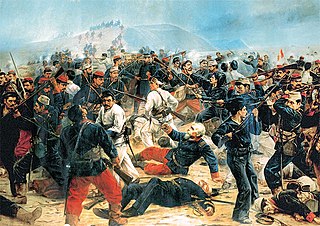
The Battle of Arica, also known as Assault and Capture of Cape Arica, was a battle in the War of the Pacific. It was fought on 7 June 1880, between the forces of Chile and Peru.
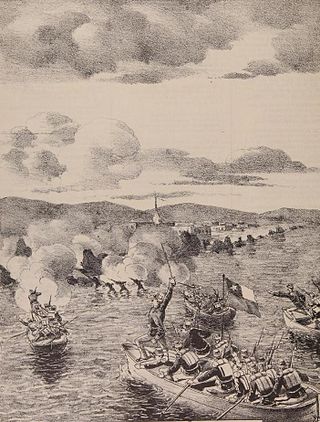
The Battle of Pisagua, was a landing operation of the War of the Pacific, fought on November 2, 1879, between Chile and the combined forces of Bolivia and Peru. The Chilean army commanded by Erasmo Escala, supported by the Chilean Fleet, launched an amphibious assault on the port of Pisagua and successfully drove the defending Bolivian-Peruvian forces, led by Gen. Juan Buendia, back from the shore. They established a beachhead that allowed an initial force of about 1,000 Chilean soldiers in two assault waves to disembark onto Peruvian territory at Pisagua in Tarapacá Department. This region was the principal territory in dispute.

The Battle of San Juan, also known as the Battle of San Juan and Chorrillos, was the first of two battles in the Lima Campaign during the War of the Pacific, and was fought on 13 January 1881. This battle is really a group of smaller, yet fierce confrontations at the defensive strongholds of Villa, Chorrillos, Santiago de Surco, San Juan de Miraflores, Santa Teresa and Morro Solar. The Chilean army led by Gen. Manuel Baquedano inflicted a harsh defeat on the Peruvian army commanded by the Supreme Chief Nicolás de Piérola. The Chilean triumph eliminated the first defensive line guarding Lima, and almost obliterated the Peruvian army defending it.

The Battle of Tacna, also known as the Battle of the Peak of the Alliance, effectively destroyed the Peru-Bolivian alliance against Chile, forged by a secret treaty signed in 1873. On 26 May 1880, the Chilean Northern Operations Army led by General Manuel Baquedano González, conclusively defeated the combined armies of Peru and Bolivia commanded by Bolivian President, General Narciso Campero. The battle took place at the Inti Urqu (Intiorko) hill plateau, a few miles north of the Peruvian city of Tacna. As a result, Bolivia was knocked out of the war, leaving Peru to fight the rest of the war alone. Also, this victory consolidated the Chilean domain over the Tarapacá Department. The territory was definitively annexed to Chile after the signing of the Tratado de Ancón, in 1884, which ended the war. Tacna itself remained under Chilean control until 1929.

The Battle of Los Ángeles was a military action fought on 22 March 1880 between the Chilean and Peruvian armies during the Tacna and Arica Campaign of the War of the Pacific. The Chilean forces under Commander in chief Manuel Baquedano assaulted and defeated the Allied stronghold guided by Andrés Gamarra garrisoned at Los Angeles hill top.
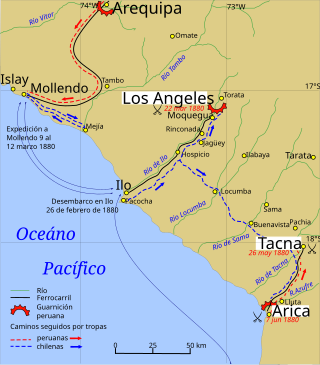
The Tacna and Arica campaign is known as the stage of the War of the Pacific after the Chilean conquest of the Peruvian department of Tarapacá, ending with Chilean domination of the Moquegua department in southern Peru. During this campaign Bolivia retired from the war after the Battle of Tacna, and Peru lost the port of Arica. Also, Manuel Baquedano assumed command as the new Commander in Chief of the Chilean Army, and the Allied Presidents were thrown out of office and replaced by Nicolas de Pierola in Peru and General Narciso Campero in Bolivia.

Tarapacá was a Department of Peru, which existed between 1878 and 1884, when it was unconditionally ceded to Chile after the War of the Pacific under the Treaty of Ancón.

After the naval campaign of the War of the Pacific was resolved, the Chilean terrestrial invasion began.

The Tarapacá campaign was a short stage of the War of the Pacific in the last months of 1879, after the Chileans won definitive naval superiority at Angamos. It took its name from the region where it was fought.

The Lima campaign is the third land campaign of the War of the Pacific, carried out by Chile between December 1880 and January 1881. The campaign ended with the Chilean occupation of the Peruvian capital and the establishment of the Chilean authority in it and other surrounding territories, which would extend until 1883, with the end of the war.

The Peruvian–Bolivian War was a warlike confrontation between Peru and Bolivia in the years 1841 and 1842.

Sofanor Parra Hermosilla, was a Chilean military officer who served in the Chilean Army, in the cavalry branch, and who reached the rank of divisional general.
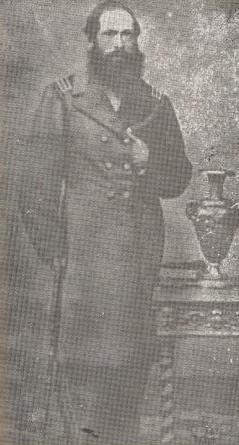
Gregorio Albarracín Lanchipa was a Peruvian Colonel and War Hero who participated in the Peruvian-Bolivian War of 1841-1842, the Peruvian Civil War of 1843–1844, the Peruvian Civil War of 1856–1858 and the War of the Pacific. He is known as El Centauro de las Vilcas as he was notable for using a vilca, a typical tree from Tacna, as a pole to raise the Peruvian flag during the Chilean administration of the area.
The Battle of Buenavista was a battle of the Tacna and Arica campaign of the War of the Pacific on April 18, 1880, between a Chilean cavalry detachment led by Commander José Francisco Vergara, and the forces of Colonel Gregorio Albarracín in the Sama River, Tacna Province, Peru.
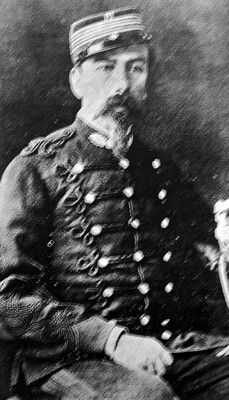
Tomás Segundo Yávar Ruiz de Cabrera was a Chilean cavalry colonel of the Chilean Army who was a war hero of the War of the Pacific before being killed at the Battle of San Juan and Chorrillos.
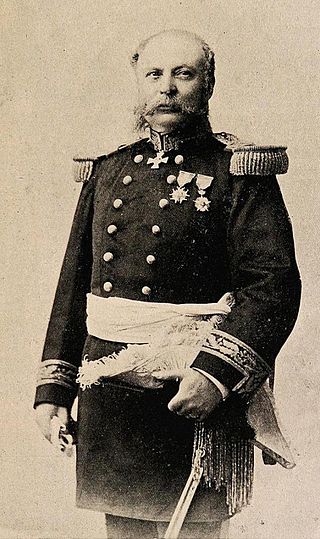
Arístides Martínez Cuadros was a Chilean general and politician who was the President of the Senate of Chile from June 2, 1884, to September 15, 1884. He was also a primary commander throughout the War of the Pacific and its campaigns.
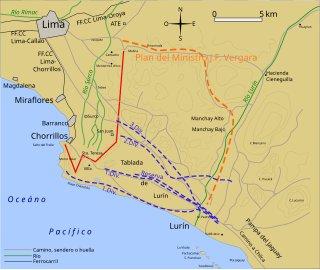
The Battle of La Rinconada de Ate took place during the Lima campaign of the War of the Pacific. The battle occurred a few days before the Battle of San Juan and Chorrillos due to a surveying conflict.

















